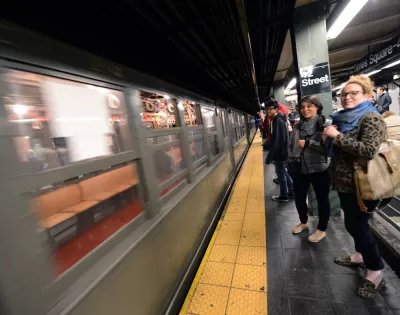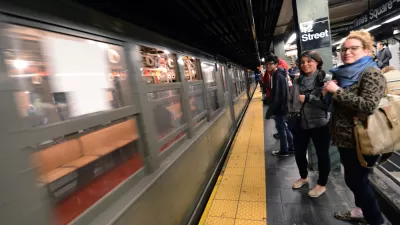Transit in general, and buses in particular, are losing riders, especially during off peak hours. Car pooling is down sharply as well.

From 1996 to 2014 public transit ridership in the United States increased more or less steadily, with much of that growth coming from gains in New York subway ridership. Now that trend is over, and transit ridership is on the decline. This decline has taken place even as the country's population has increased, meaning that the per capita declines are even more pronounced.
"What I argue here is that what we’re seeing now is unquestionably a decline in transit ridership—almost universal among large cities. Yet there are reasons to believe it isn’t a permanent shift, given that its causes don’t appear to be primarily related to technological change," Yonah Freemark writes.
Looking at commuting, Freemark finds the dominance of driving alone isn't new but a trend that can be tracked back to at least the seventies. In past decades, carpooling accounted for more than 20 percent of all trips to and from work, now carpooling, transit, walking, and biking put together don't add up to even 25 percent of trips. "The significant decline over the past few years is reinforcing what has been happening for ages, probably not reflecting the availability of new transportation modes likes ride-hailing or a sudden change of interest of the public away from transit," Freemark argues.
But talk of a transit collapse may end up a self-fulfilling prophecy. If officials, convinced by grim arguments about transit, decide to forgo investment in favor of more car-focused infrastructure and to let private services like Uber handle mobility, then a few years of falling ridership could turn into a death spiral.
FULL STORY: U.S. transit systems are shedding riders. Are they under threat?

Alabama: Trump Terminates Settlements for Black Communities Harmed By Raw Sewage
Trump deemed the landmark civil rights agreement “illegal DEI and environmental justice policy.”

Planetizen Federal Action Tracker
A weekly monitor of how Trump’s orders and actions are impacting planners and planning in America.

The 120 Year Old Tiny Home Villages That Sheltered San Francisco’s Earthquake Refugees
More than a century ago, San Francisco mobilized to house thousands of residents displaced by the 1906 earthquake. Could their strategy offer a model for the present?

Indy Neighborhood Group Builds Temporary Multi-Use Path
Community members, aided in part by funding from the city, repurposed a vehicle lane to create a protected bike and pedestrian path for the summer season.

Congestion Pricing Drops Holland Tunnel Delays by 65 Percent
New York City’s contentious tolling program has yielded improved traffic and roughly $100 million in revenue for the MTA.

In Both Crashes and Crime, Public Transportation is Far Safer than Driving
Contrary to popular assumptions, public transportation has far lower crash and crime rates than automobile travel. For safer communities, improve and encourage transit travel.
Urban Design for Planners 1: Software Tools
This six-course series explores essential urban design concepts using open source software and equips planners with the tools they need to participate fully in the urban design process.
Planning for Universal Design
Learn the tools for implementing Universal Design in planning regulations.
Clanton & Associates, Inc.
Jessamine County Fiscal Court
Institute for Housing and Urban Development Studies (IHS)
City of Grandview
Harvard GSD Executive Education
Toledo-Lucas County Plan Commissions
Salt Lake City
NYU Wagner Graduate School of Public Service





























